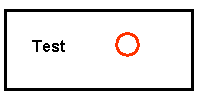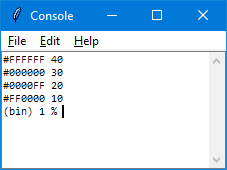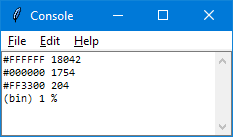import java.util.*;class I {public static void main(String[] a) throws Exception {java.awt.image.BufferedImage i = javax.imageio.ImageIO.read(new java.io.File(a[0]));Map m=new HashMap();String s;for(Integer x=0,y=0,c;y<i.getHeight();y++)for(x=0;x<i.getWidth();m.put(s=x.toHexString(((c=i.getRGB(x++,y))&0xff0000)>>16)+x.toHexString((c & 0xff00)>>8)+x.toHexString(c&0xff),m.get(s)==null?1:(int)m.get(s)+1));System.out.print(m);}}
Try it online! (Doesn't work online)
Ungolfed:
import java.util.*;
class I {
public static void main(String[] a) throws Exception {
java.awt.image.BufferedImage i = javax.imageio.ImageIO
.read(new java.io.File(a[0]));
Map m = new HashMap();
String s;
for (Integer x = 0, y = 0, c; y < i.getHeight(); y++)
for (x = 0; x < i.getWidth(); m
.put(s = x.toHexString(((c = i.getRGB(x++, y)) & 0xff0000) >> 16)
+ x.toHexString((c & 0xff00) >> 8)
+ x.toHexString(c & 0xff), m.get(s) == null ? 1
: (int) m.get(s) + 1))
;
System.out.print(m);
}
}
The toString() of map outputs like this:
{7c7c7c=6, 1d57a5=20468, 121212=7, d3d3d3=3, bdbdbd=9, 949494=2, 333=14, 626262=3, cacaca=2, 141414=5, fff=11, c9c9c9=1, e8e8e8=1, 919191=4, 161616=5, c2c2c2=1, 646464=7, 979797=12, fafafa=2, 808080=1, 7b7b7b=1, 484848=4, b9b9b9=2, f1f1f1=2, 6b6b6b=6, 363636=15, 262626=4, d8d8d8=2, 868686=4, 757575=1, 575757=3, a7a7a7=2, cecece=2, dcdcdc=2, c3c3c3=2, 1d1d1d=5, 727272=9, 656565=2, 3a3a3a=3, 7d7d7d=10, 393939=5, 797979=3, 222=31, 8f8f8f=2, 454545=4, 181818=9, 2e2e2e=2, 222222=1, 1c1c1c=19, b8b8b8=2, e1e1e1=5, 232323=5, 8a8a8a=3, 959595=7, 6a6a6a=9, 434343=7, 5c5c5c=3, 111=20, 909090=3, 424242=4, 212121=1, 1a1a1a=6, 202020=7, efefef=1, 565656=5, 6e6e6e=7, 767676=3, 323232=2, eee=5, 444=18, 2c62ab=1, 717171=2, b1b1b1=3, 6c6c6c=3, 545454=7, 515151=17, 2f2f2f=2, 4a4a4a=3, 888888=6, 6d6d6d=3, 898989=3, a3a3a3=5, 7e7e7e=9, ddd=9, b6b6b6=3, 2b2b2b=5, 313131=5, 8d8d8d=1, a2a2a2=2, 696969=3, a5a5a5=3, 4f4f4f=5, 828282=7, 191919=5, 606060=4, 6f6f6f=4, 8b8b8b=3, ebebeb=2, 555=19, 929292=3, 131313=11, 999999=5, d2d2d2=2, 444444=9, 474747=4, dddddd=1, 585858=8, 5a5a5a=3, 000=9887, afafaf=2, dfdfdf=3, 747474=3, 666666=4, a1a1a1=4, 2a2a2a=11, 4d4d4d=6, 818181=2, 878787=5, 215aa6=1, d9d9d9=4, b5b5b5=3, b4b4b4=3, 737373=4, aeaeae=3, bbb=15, 242424=4, 2d2d2d=8, 888=19, c1c1c1=1, 494949=9, dbdbdb=5, ccc=19, 5d5d5d=3, 5f5f5f=1, 414141=6, c8c8c8=3, aaa=16, 1e1e1e=3, 707070=2, 9e9e9e=2, 373737=7, 9d9d9d=2, 1b1b1b=4, 303030=7, 535353=10, 595959=2, 8e8e8e=3, 383838=5, 939393=18, 616161=2, 686868=6, dadada=1, e3e3e3=2, 5b5b5b=3, a4a4a4=5, 8c8c8c=5, a6a6a6=11, 292929=6, 4c4c4c=3, 151515=6, fefefe=2, 787878=2, 505050=2, e2e2e2=1, 1f1f1f=9, adadad=2, ababab=1, 5e5e5e=6, 252525=4, 4e4e4e=3, 282828=7, a8a8a8=4, 9c9c9c=3, aaaaaa=1, 101010=5, b7b7b7=2, 969696=6, 7f7f7f=4, 555555=2, a9a9a9=5, 343434=8, 999=17, 777777=3, ffffff=76669, f0f0f0=4, bbbbbb=1, 1e58a5=1, b3b3b3=4, 777=20, 636363=2, d4d4d4=1, 2c2c2c=5, 848484=1, 3c3c3c=3, bfbfbf=2, 3e3e3e=9, 333333=4, 7a7a7a=3, 858585=4, 4b4b4b=3, 272727=7, 111111=6, 666=13, 9b9b9b=1, bcbcbc=4, cfcfcf=2, 9a9a9a=1, 404040=21, 525252=3, 989898=4, 171717=5, 3b3b3b=2, c4c4c4=1, 3f3f3f=7, 464646=1, cdcdcd=2, b2b2b2=33, c5c5c5=2, bababa=2}
Please don't post 1.8 specific golfs suggestions, unless it works in older Java, me no want.
Example: Lambdas don't work in more versions of Java than they do work in.










count descendingis a bit unclear. How do we sort it? – Rɪᴋᴇʀ – 2016-06-04T14:12:52.673@EᴀsᴛᴇʀʟʏIʀᴋ: descending: most frequent color at the top – Thomas Weller – 2016-06-04T14:17:14.360
Okay, I would say that needs to be a bit more clear. Maybe say something like
the most frequent colors at the top? – Rɪᴋᴇʀ – 2016-06-04T14:18:52.347@EᴀsᴛᴇʀʟʏIʀᴋ: I agree, just updated the question for both – Thomas Weller – 2016-06-04T14:19:19.903
1A couple of test cases would be good. – Martin Ender – 2016-06-04T14:54:21.953
If your language doesn't support any image formats (no file support) what input can we take? – Blue – 2016-06-04T15:51:58.127
Some image formats are indexed, which means each pixel contains a pointer to a color in the colormap. Is that accepted? – Luis Mendo – 2016-06-04T15:57:03.030
@LuisMendo: you can look up the hex value in that color table, that's fine. It's not allowed to print the index instead of the hex value. – Thomas Weller – 2016-06-04T16:00:23.307
@muddyfish Not sure if that's allowed for challenges tagged image-processing. I asked a question on meta
– Thomas Weller – 2016-06-04T16:04:59.283@ThomasWeller This image is a nice test because it only has three colours an it's visually obvious what the order should be
– Luis Mendo – 2016-06-04T16:29:50.040Is the leading
#required? – Luis Mendo – 2016-06-04T17:24:31.863Can I additionally output transparency, even though it doesn't matter? For example,
ffff0000instead offf0000for pure red? Also, echoing Luis' question about the leading#being required. – AdmBorkBork – 2016-06-06T15:29:22.510@LuisMendo: yes, the hash is required, as shown in all the expected outputs. I clarified that in the question. – Thomas Weller – 2016-06-06T15:35:18.763
@TimmyD: the alpha value may not be part of the output as shown in all the expected outputs. I clarified that in the question. – Thomas Weller – 2016-06-06T15:35:57.887